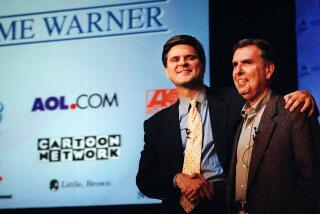AOL’s New Chief Inherits Hurdles
Job No. 1 for Jonathan Miller, named Tuesday as chief executive of America Online, will be helping the company figure out what it wants to be, now that it’s all grown up.
AOL burst into the American mainstream in the mid-1990s with its friendly, easy-to-use Internet service and signed up millions of customers.
Once a scrappy technology start-up, AOL today finds itself mired in the problems of a mature company struggling to keep up with a technology revolution it helped ignite.
Over the last two years, the Dulles, Va.-based online service has fallen from being one of America’s most highly touted businesses to a troubled entity valued at virtually nothing on Wall Street in the aftermath of the merger that created AOL Time Warner Inc.
Worldwide, AOL counts about 34 million subscribers, about 25 million of them in the United States--far ahead of its largest rival, Microsoft Corp.’s MSN service, with 7.7 million domestic customers. However, most of AOL’s customers use a slow dial-up phone connection, and more business is migrating to higher-speed Internet access.
“They’re the king of the dial-up business, which throws off a lot of cash,” said Blair Levin, analyst at Legg Mason in Washington. “But it’s a diminishing business. The trends are not favorable to them.”
Miller, 45, an e-commerce veteran at Barry Diller’s USA Interactive Inc., said in an interview Tuesday that he was aware of the hurdles he has inherited at AOL. But he disagrees about their degree of severity.
“I don’t think the company is off in a terribly wrong way,” said Miller, who promised to unveil a new business plan for AOL by this fall. “It just needs to be refocused. It’s a very big, very profitable business. The challenge is to keep it that way.”
High-Speed or Dial-Up?
At the heart of the debate over AOL is whether the company should reinvent itself as a traditional media property, a sort of online magazine or television network with a strong emphasis on programming and content, or pay closer attention to technology.
While the bulk of online subscribers continue to rely on the type of dial-up service that AOL dominates, increasing numbers of people are opting for high-speed Internet connections via their cable or phone companies.
“AOL has to deal with the slowing growth in dial-up subscribers,” said Chris Charron, a research director with Forrester Research Inc. in Cambridge, Mass. “They need to figure out how to move subscribers to a broadband environment.”
Here, AOL’s chief obstacle has been its inability to cut crucial deals with cable companies to offer its online service across their high-speed lines. AOL is negotiating with AT&T; Corp., Comcast Corp. and others, but there are disagreements over who should control the customer relationship and how profits should be divided.
Without a contract with a large cable operator, “this business could be a single-digit growth business, if they’re lucky,” said Michael Gallant, an analyst at CIBC World Markets.
Analysts estimate that AOL has sold high-speed service to only about 500,000 subscribers, including 400,000 on digital subscriber lines (DSL) telephone lines and 100,000 on its sister cable company, Time Warner Cable.
However, the rollout of broadband has been much slower than most people anticipated and the market remains fragmented, giving AOL some breathing space.
Last year, about 11.1 million homes had high-speed Internet access in the United States. This year, that figure is projected to increase to 18.8 million, or about 14% of U.S. households, according to Forrester.
Miller is the third boss at America Online this year, part of a broad reshuffling of management at AOL Time Warner’s executive suite.
Miller acknowledged AOL’s challenge to win broadband subscribers, but he saw no need to box AOL into a certain category. Nor was he worried that the company will be eclipsed by broadband.
“People like to put things in specific buckets because it’s easier to talk about,” Miller said. “But when you look at AOL today, it’s media, it’s e-commerce and it’s Internet. It’s all of the above.”
Miller declined to talk about specific changes he plans to make, but said his forthcoming business plan would focus on improving content and leveraging e-commerce opportunities. Miller also plans to focus on developing new features specifically targeted at broadband customers.
Loyal Customers
AOL boasts that it holds several advantages in a broadband world, including the use of Time Warner music and movies, and strong customer loyalty. Many AOL users are loath to give up their e-mail addresses and AOL’s proprietary instant-messaging system, which has about 55 million users nationwide, or more than MSN and Yahoo combined.
AOL recently broke a promise to allow other instant-messaging services to connect to its service, saying the technology and security hurdles are too high. That should allow AOL to maintain its lock on the instant-message market.
Such loyalty is already helping AOL compete in the broadband market. Even when AOL customers buy high-speed access from a rival company, as many as 3 million still opt to continue paying for AOL each month, analysts estimate.
Dial-up Internet service “is a hugely profitable business and it’s not going away tomorrow. Broadband is a slow build. It’s going to take longer,” Miller said. “The opportunity to lead in broadband is still very much in AOL’s future.”
Restoring Stability
Miller’s boss, Don Logan, who was recently named to head AOL Time Warner’s media properties, predicted that Miller’s arrival should help reduce the confusion about the AOL’s identity and restore stability.
“There have been tremendous management changes,” Logan said. “With that there have been movements back and forth, shifts in priorities. We weren’t as consistent as we should have been. You would expect the organization to be whipsawed.”
When AOL began offering easy Internet access in the mid-1980s, few rivals had the kind of services and content that AOL boasted. In 1996, AOL also pioneered the practice of charging a flat monthly rate, and consumers flocked to the Internet.
“The Internet is more mature now, and AOL is being eaten away by specialists that provide just one service, whether it’s auctions or tickets or travel,” said Charron of Forrester Research. “Does AOL continue to try to be all things to all people? Do they need to specialize?”
As Miller sorts out AOL’s priorities, smaller rivals--including movie ticket, travel and financial Web sites--continue to nibble at its heels, siphoning off advertising and e-commerce revenues.
Denise Garcia, media research director at GartnerG2, said despite AOL’s recent ad slump, the unit still must focus on revitalizing ad sales and rebuilding its sales force, which has suffered from heavy turnover. Advertising and commerce revenue at the AOL unit fell 42% during the second quarter ended June 30.
“They need to focus on straightforward, cash ad deals, not these business development deals,” Garcia said, referring to the kind of creative marketing deal that AOL has engaged in recently. Some of those deals are now the focus of a criminal probe by the Justice Department.
More E-Commerce
Analysts are predicting that Miller will bring his e-commerce skills to bear in devising a growth strategy for AOL, particularly as advertising continues its slump and subscriber growth is stagnating.
“I anticipate that we will see e-commerce becoming a bigger piece of the puzzle,” Charron said.
“AOL could either purchase an online merchant or promote e-commerce more prominently as a place where people can go to not only get the product, but also get the lowdown on the product with reviews from the AOL community,” he said.
Meanwhile, Miller faces another challenge: low staff morale.
To help boost morale, managers have been sending out regular e-mails to employees.
But the collapse of AOL Time Warner’s stock price has stung. The stock fell 5 cents Tuesday to close at $9.90 on the New York Stock Exchange. It has fallen 90% from its record high of $95.81 in December 1999.
In the past, many employees could earn more each year by cashing in stock options than they did from their base salary. No more. Today, most of those options are deep underwater, and for the first time in years, many employees are living on their paychecks alone.
More to Read
The biggest entertainment stories
Get our big stories about Hollywood, film, television, music, arts, culture and more right in your inbox as soon as they publish.
You may occasionally receive promotional content from the Los Angeles Times.










